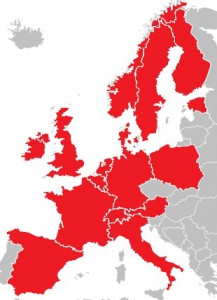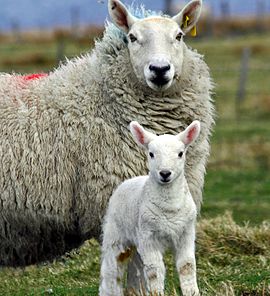
As if the recent bout of cold weather hadn’t sufficiently served to increase the fears of British livestock farmers struggling with livestock losses, in addition to the falling price of lamb, several European countries, including the UK, are currently subject to the emergence of a devastating arbovirus affecting ruminant animals – Schmallenberg virus (SBV). Although not considered a notifiable disease, SBV was first detected in Germany in November 2011 [1] and is responsible for neurological defects, stillbirths and late abortions in sheep, cattle and goats [1-3]. However, there is a low likelihood of any risk to public health.
As an arbovirus, SBV has rapidly spread throughout Europe by infected vectors such as midges, mosquitoes and ticks. Favourable climate conditions reported in 2011 have lead experts to believe that the spread of the virus to South and East England in early 2012 was due to infected midges from Europe being carried over the channel, and feeding on domestic livestock [4].
 With more than 5,000 cases of SBV reported since its discovery in Britain, the virus has recently been detected in Dumfries and Galloway, Scotland, but there are fears that SBV is still being underreported.
With more than 5,000 cases of SBV reported since its discovery in Britain, the virus has recently been detected in Dumfries and Galloway, Scotland, but there are fears that SBV is still being underreported.
Uncertainty over the longterm damage SBV might cause has prompted calls to accelerate development of a vaccine, and progress is being made by several research groups to advance the knowledge of this virus. Using a technique known as ‘reverse genetics’, scientists from the University of Glasgow have successfully created a viral ‘genome’ for SBV, which they are able to manipulate, and have identified a gene (NSs) involved in protecting the virus against the immune response of infected animals (4). Such research premits the manipulation of the virus in order to develop and test novel vaccines against this newly emerged disease.
To reflect the urgency with which new research is needed to help tackle this disease, BMC Veterinary Research will be publishing a thematic issue entitled ‘Advances in Schmallenberg Virus Research’. This timely thematic series will focus on all areas of research into SBV to help promote advances in this field.
Potential topics to the series could include, but are not limited to:
- Advances in SBV genetics
- Pathogenesis of SBV infection on host
- Potential factors encouraging spread of SBV
- Advances in vaccine development
- Epidemiological spread of SBV, including health outcomes and policy updates
Submissions of Research, Debate, Methodology and Review articles are all encouraged.
 Submission is open to everyone, and all submitted manuscripts will be peer-reviewed through the regular BMC Veterinary Research review process. All accepted manuscripts will be published together in one special thematic section. BMC Veterinary Research is an open-access journal.
Submission is open to everyone, and all submitted manuscripts will be peer-reviewed through the regular BMC Veterinary Research review process. All accepted manuscripts will be published together in one special thematic section. BMC Veterinary Research is an open-access journal.
Deadline for submission is: 30th September 2013.
Please submit your manuscript via BMC Veterinary Research indicating within your cover letter that you wish your manuscript to be considered as part of the ‘Advances in Schmallenberg Virus Research’ thematic series. Feel free to direct pre-submission enquiries to hayley.henderson@biomedcentral.com.
We look forward to hearing from you.
Dr Hayley Henderson (Executive Editor)
BMC Veterinary Research
1. Hoffmann B, Scheuch M, Höper D, Jungblut R, Holsteg M, Schirrmeier H, Eschbaumer M, Goller KV, Wernike K, Fischer M, Breithaupt A, Mettenleiter TC, Beer M: Novel orthobunyavirus in cattle, europe, 2011. Emerging Infectious Diseases 2012, 18:469–472.
2. Kupferschmidt K: Infectious disease. scientists rush to find clues on new animal virus. Science 2012, 335: 1028–1029.
3. Beer M, Conraths FJ, WH VDP: ‘Schmallenberg virus’- a novel orthobunyavirus emerging in Europe. Epidemiology and Infection 2012, 141:1–8.
4. Varela M, Schnettler E, Caporale M, Murgia C, Barry G, McFarlane M, McGregor E, Piras IM, Shaw P, Lamm C, Janowicz A, Beer M, Glass M, Herder V, Hahn K, Baumgartner W, Kohl A, Palmarini M: Schmallenberg virus pathogenesis, tropism and interaction with the innate immune system of the host. PLoS Pathogens 2013, 9(1): e1003133. doi:10.1371/journal.ppat.1003133
Comments